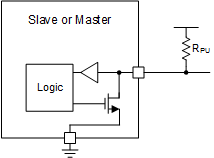SLVA704 June 2015 INA209 , INA219 , INA220 , INA220-Q1 , INA223 , INA226 , INA226-Q1 , INA228 , INA228-Q1 , INA230 , INA231 , INA233 , INA234 , INA237 , INA237-Q1 , INA238 , INA238-Q1 , INA3221 , INA3221-Q1 , LM8323 , LM8325-1 , LM8327 , LM8328 , LM8330 , LM8333 , LM8335 , OPT3001 , OPT3004 , P82B715 , P82B96 , PCA6107 , PCA9306 , PCA9306-Q1 , PCA9515A , PCA9515B , PCA9518 , PCA9534 , PCA9534A , PCA9535 , PCA9536 , PCA9538 , PCA9539 , PCA9543A , PCA9544A , PCA9545A , PCA9546A , PCA9548A , PCA9554 , PCA9554A , PCA9555 , PCA9557 , PCF8574 , PCF8574A , PCF8575 , PCF8575C , TCA4311A , TCA5405 , TCA6408A , TCA6416A , TCA6418E , TCA6424A , TCA6507 , TCA8418 , TCA8418E , TCA8424 , TCA9406 , TCA9509 , TCA9517 , TCA9517A , TCA9534 , TCA9534A , TCA9535 , TCA9538 , TCA9539 , TCA9539-Q1 , TCA9543A , TCA9544A , TCA9545A , TCA9546A , TCA9548A , TCA9554 , TCA9554A , TCA9555 , TCA9617A , TCA9617B , TCA9800 , TCA9801 , TCA9802 , TCA9803
1.1 Open-Drain for Bidirectional Communication
Open-drain refers to a type of output which can either pull the bus down to a voltage (ground, in most cases), or "release" the bus and let it be pulled up by a pull-up resistor. In the event of the bus being released by the master or a slave, the pull-up resistor (RPU) on the line is responsible for pulling the bus voltage up to the power rail. Since no device may force a high on a line, this means that the bus will never run into a communication issue where one device may try to transmit a high, and another transmits a low, causing a short (power rail to ground). I2C requires that if a master in a multi-master environment transmits a high, but see's that the line is low (another device is pulling it down), to halt communications because another device is using the bus. Push-pull interfaces do not allow for this type of freedom, which is a benefit of I2C.
 Figure 2. Basic Internal Structure of SDA/SCL Line
Figure 2. Basic Internal Structure of SDA/SCL Line Figure 2 shows a simplified view of the internal structure of the slave or master device on the SDA/SCL lines, consisting of a buffer to read input data, and a pull-down FET to transmit data. A device is only able to pull the bus line low (provide short to ground) or release the bus line (high impedance to ground) and allow the pull-up resistor to raise the voltage. This is an important concept to realize when dealing with I2C devices, since no device may hold the bus high. This property is what allows bidirectional communication to take place.